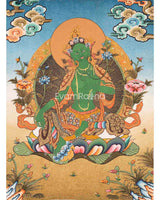
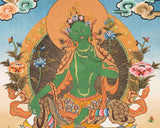
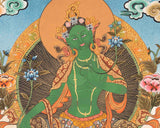
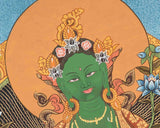
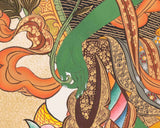
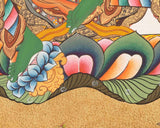
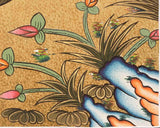
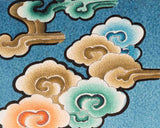
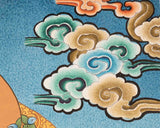
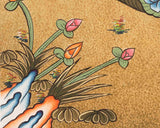
Green Tara Thangka | Healing Female Deity | Wall Decors

100% AUTHENTIC

HANDPAINTED

FREE SHIPPING
Green Tara Thangka
Introduction To The Thangka :
The fully realized female Buddha is known as Tara. It is believed that Tara was born from Avalokiteshvara's compassionate tears. In the Buddhist faith, she represents enlightenment in a female form.
After practicing thangka, we get intense sentiments of joy, contentment, and connectedness. She frees sentient creatures from the eight great fears, particularly in the guise of Sengdeng Nagchi Drölma, the Green Tara.
How does Thangka benefit us?
Every component of a painting is symbolic. Whether you practice Buddhism or hold other religious beliefs, a thangka can aid you on your path to enlightenment regardless of your religious affiliation. Thangkas are paintings of gods that include a variety of iconographic details and symbolism to promote meditation on the gods' teachings. Any thangka is meant to help break through the film of ignorance, which is a major impediment to the path to enlightenment. The Thangka is honored as a sacred object. They propagate the teachings of Buddhism, bring about peace, harmony, and oneness, as well as neutralize any potential negative energy.
------------------------------------------------------------------
Size: 14"/ 36 cm (width) x 19"/ 48 cm (height)
Materials: Cotton Canvas, Acrylic Colors, Genuine 24K Gold
------------------------------------------------------------------
How to take care of your thangka?
-Hang your thangka in a traditional silk brocade
-Regular Inspection of your thangka; examine the borders and all attachments.
-Keep thangkas covered when they are on display but not in use.
-Rotate thangkas between display and storage on a regular basis, two to four times a year, to reduce the amount of exposure to light. Keep away from sunlight and humidity.
-Do not apply liquids or other materials to the surface of the thangka.
How to Take Care of Your Thangka?
- Hang your thangka in a traditional silk brocade.
- Regularly inspect your thangka; examine the borders and all attachments.
- Keep thangkas covered when they are on display but not in use.
- Rotate thangkas between display and storage two to four times a year to reduce exposure to light. Keep them away from sunlight and humidity.
- Do not apply liquids or other materials to the surface of the thangka.




















